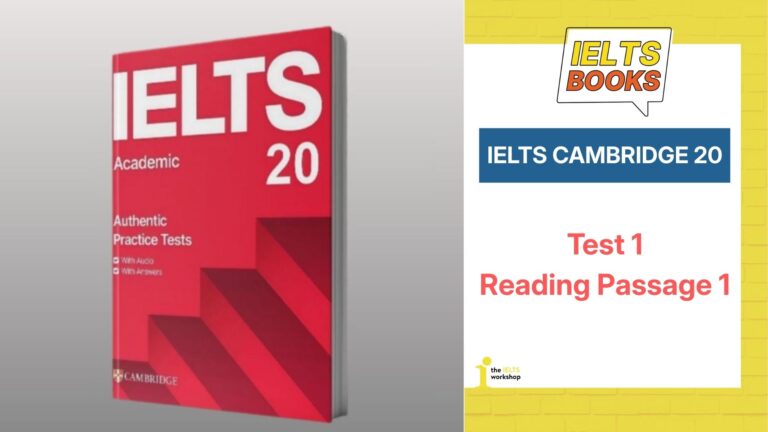Bạn đang băn khoăn chưa biết cải thiện khi giải đề IELTS dạng bài reading vì nó đòi hỏi rất nhiều kĩ năng? Nếu bạn đang bắt tay vào giải đề IELTS Cambridge 20 Test 1 Reading Passage 1 thì đừng lo bài viết dưới đây cung cấp đáp án và hướng dẫn giải chi tiết giúp bạn tránh nhầm đường lạc lối trên hành trình chinh phục band điểm IELTS mơ ước của mình.
Đáp án IELTS Cambridge 20 Test 1 Reading Passage 1
| Câu hỏi | Đáp án |
|---|---|
| 1 | FALSE |
| 2 | FALSE |
| 3 | FALSE |
| 4 | NOT GIVEN |
| 5 | TRUE |
| 6 | TRUE |
| 7 | bulbs |
| 8 | soil |
| 9 | feathers |
| 10 | deer |
| 11 | 1980 |
| 12 | funding |
| 13 | stakeholders |
Phân tích chi tiết IELTS Cambridge 20 Test 1 Reading Passage 1
Question 1. FALSE
Câu hỏi: There are other parrots that share the kakapo’s inability to fly. (Có các loài vẹt khác cũng không biết bay giống như loài kakapo.)
Vị trí: Đoạn 1.
Transcript: It is the world’s only flightless parrot.
Phân tích: Bài đọc khẳng định kakapo là loài vẹt duy nhất không bay được, trong khi câu hỏi lại cho rằng có nhiều loài khác cùng đặc điểm. → Mâu thuẫn.
Question 2. FALSE
Câu hỏi: Adult kakapo produce chicks every year. (Kakapo trưởng thành sinh con mỗi năm.)
Vị trí: Đoạn 3
Transcript: Kākāpō breed in summer and autumn, but only in years when food is plentiful.
Phân tích: Kakapo chỉ sinh sản khi thức ăn dồi dào, không phải hàng năm → mâu thuẫn.
Question 3. FALSE
Câu hỏi: Adult male kakapo bring food back to nesting females. (Kakapo đực trưởng thành mang thức ăn về cho con cái đang ấp trứng.)
Vị trí: Đoạn 3.
Transcript: Males play no part in incubation or chick-rearing – females alone incubate eggs and feed the chicks. The female kākāpō has to spend long periods away from the nest searching for food.
Phân tích: Con đực không tham gia bất cứ vai trò nào trong nuôi dưỡng hoặc ấp trứng → sai.
Question 4. NOT GIVEN
Câu hỏi: The Polynesian rat was a greater threat to the kakapo than Polynesian settlers. (Chuột Polynesia là mối đe dọa lớn hơn với kakapo so với những người Polynesia.)
Vị trí: Đoạn 4.
Transcript: With them came the Polynesian dog and rat, which also preyed on kākāpō.
Phân tích: Bài chỉ nói cả người và chuột đều săn kakapo, không so sánh mức độ đe dọa → không có thông tin.
Question 5. TRUE
Câu hỏi: Kakapo were transferred from Rakiura island to other locations because they were at risk from feral cats. (Kakapo được chuyển khỏi đảo Rakiura do bị đe dọa bởi mèo hoang.)
Vị trí: Đoạn 7.
Transcript: Unfortunately, predation by feral cats on Rakiura Island led to a rapid decline in kākāpō numbers. As a result, during 1980–97, the surviving population was evacuated to three island sanctuaries.
Phân tích: Mèo hoang làm số lượng kakapo giảm mạnh, dẫn đến việc di chuyển chúng sang các đảo khác → đúng.
Question 6. TRUE
Câu hỏi: One Recovery Plan initiative that helped increase the kakapo population size was caring for struggling young birds. (Một biện pháp trong Kế hoạch Phục hồi giúp tăng số lượng kakapo là chăm sóc chim non yếu.)
Vị trí: Đoạn 8.
Transcript: This involved moving the birds between islands, supplementary feeding of adults and rescuing and hand-raising any failing chicks.
Phân tích: Việc nuôi dưỡng những con non yếu là một phần trong kế hoạch giúp tăng số lượng → đúng.
Question 7. bulbs
Câu hỏi: diet consists of fern fronds, various parts of a tree and …………… (Chế độ ăn bao gồm lá dương xỉ, các phần khác nhau của cây và …)
Vị trí: Đoạn 2.
Transcript: … with their diet including the leaves, roots and bark of trees as well as bulbs, and fern fronds.
Phân tích: Bulbs là phần còn thiếu trong danh sách thức ăn → đúng.
Question 8. soil
Câu hỏi: nests are created in ……………… where eggs are laid (Tổ được làm trong … nơi trứng được đẻ)
Vị trí: Đoạn 3.
Transcript: The 1–4 eggs are laid in soil, which is repeatedly turned over before and during incubation.
Phân tích: Trứng được đẻ trong đất → soil là từ cần điền.
Question 9. feathers
Câu hỏi: the …………………. of the kakapo were used to make clothes (… của kakapo được dùng để làm quần áo)
Vị trí: Đoạn 4.
Transcript: … used its feathers to make soft cloaks.
Phân tích: Lông vũ của kakapo được dùng làm áo → feathers là từ chính xác.
Question 10. deer
Câu hỏi: ………………. were an animal which they introduced that ate the kakapo’s food (… là loài động vật được họ đưa vào và đã ăn thức ăn của kakapo)
Vị trí: Đoạn 4.
Transcript: … introduced species such as deer depleted the remaining forests of food.
Phân tích: Deer là loài tiêu thụ nguồn thức ăn của kakapo → phù hợp.
Question 11. 1980
Câu hỏi: a definite sighting of female kakapo on Rakiura island was reported in the year …………… (Một lần chắc chắn phát hiện kakapo cái ở đảo Rakiura được ghi nhận vào năm …)
Vị trí: Đoạn 6.
Transcript: … in 1980 it was confirmed females were also present.
Phân tích: Thông tin về việc xác nhận cá thể cái xuất hiện được nêu rõ là năm 1980.
Question 12. funding
Câu hỏi: the Recovery Plan included an increase in ……………….. (Kế hoạch Phục hồi bao gồm một sự gia tăng về …)
Vị trí: Đoạn 8.
Transcript: … a higher amount of funding.
Phân tích: Funding là nội dung được đề cập rõ trong quá trình cải tổ kế hoạch → phù hợp.
Question 13. stakeholders
Phân tích: Mục tiêu hiện tại là giữ cho stakeholders tiếp tục tham gia → phù hợp.
Câu hỏi: a current goal of the Recovery Plan is to maintain the involvement of ……………….. in kakapo protection (Một mục tiêu hiện tại của Kế hoạch Phục hồi là duy trì sự tham gia của … trong việc bảo vệ kakapo)
Vị trí: Đoạn 10.
Transcript: … ensure stakeholders continue to be fully engaged in the preservation of the species.
Dịch chi tiết IELTS Cambridge 20 Test 1 Reading Passage 1
The Kākāpō
The kākāpō is a nocturnal, flightless parrot that is critically endangered and one of New Zealand’s unique treasures
(Kākāpō là loài vẹt sống về đêm, không biết bay, đang bị đe dọa nghiêm trọng và là một trong những báu vật độc đáo của New Zealand)
1. The kākāpō, also known as the owl parrot, is a large, forest-dwelling bird, with a pale owl-like face. Up to 64 cm in length, it has predominantly yellow-green feathers, forward-facing eyes, a large grey beak, large blue feet, and relatively short wings and tail. It is the world’s only flightless parrot, and is also possibly one of the world’s longest-living birds, with a reported lifespan of up to 100 years.
(Kākāpō, còn được gọi là vẹt cú, là một loài chim lớn sống trong rừng, có khuôn mặt nhợt nhạt giống cú. Với chiều dài lên đến 64 cm, loài chim này có bộ lông chủ yếu màu xanh vàng, đôi mắt hướng về phía trước, mỏ lớn màu xám, chân to màu xanh lam và đôi cánh cùng đuôi tương đối ngắn. Đây là loài vẹt duy nhất trên thế giới không biết bay, và có thể là một trong những loài chim sống thọ nhất, với tuổi thọ được ghi nhận lên đến 100 năm.)
Từ vựng cần nhớ:
- forest-dwelling: sống trong rừng
- flightless: không có khả năng bay
2. The kākāpō are solitary birds and tend to occupy the same home range for many years. They forage on the ground and climb high into trees. They often leap from trees and flap their wings, but at best manage a controlled descent to the ground. They are entirely vegetarian, with their diet including the leaves, roots and bark of trees as well as bulbs, and fern fronds.
(Kākāpō là loài sống đơn độc và thường sống cố định trong một khu vực trong nhiều năm. Chúng kiếm ăn dưới đất và trèo cao lên cây. Chúng thường nhảy từ trên cây xuống và vỗ cánh, nhưng cùng lắm chỉ có thể hạ cánh một cách có kiểm soát xuống mặt đất. Chúng hoàn toàn ăn thực vật, với chế độ ăn bao gồm lá cây, rễ và vỏ cây cũng như củ và lá dương xỉ non.)
Từ vựng cần nhớ:
- solitary: đơn độc
- forage: kiếm ăn
- fronds: lá non (thường là của dương xỉ)
3. Kākāpō breed in summer and autumn, but only in years when food is plentiful. Males play no part in incubation or chick-rearing – females alone incubate eggs and feed the chicks. The 1–4 eggs are laid in soil, which is repeatedly turned over before and during incubation. The female kākāpō has to spend long periods away from the nest searching for food, which leaves the unattended eggs and chicks particularly vulnerable to predators.
(Kākāpō sinh sản vào mùa hè và mùa thu, nhưng chỉ trong những năm thức ăn dồi dào. Con đực không tham gia ấp trứng hay nuôi con – chỉ có con cái đảm nhận việc này. Chúng đẻ từ 1 đến 4 trứng vào đất, nơi được lật lên nhiều lần trước và trong thời gian ấp. Con cái phải rời tổ trong thời gian dài để đi kiếm ăn, khiến trứng và con non không được trông chừng, trở nên đặc biệt dễ bị tấn công bởi các loài săn mồi.)
Từ vựng cần nhớ:
- plentiful: dồi dào
- incubation: sự ấp trứng
- vulnerable: dễ bị tổn thương
4. Before humans arrived, kākāpō were common throughout New Zealand’s forests. However, this all changed with the arrival of the first Polynesian settlers about 700 years ago. For the early settlers, the flightless kākāpō was easy prey. They ate its meat and used its feathers to make soft cloaks. With them came the Polynesian dog and rat, which also preyed on kākāpō. By the time European colonisers arrived in the early 1800s, kākāpō had become confined to the central North Island and forested parts of the South Island. The fall in kākāpō numbers was accelerated by European colonisation. A great deal of habitat was lost through forest clearance, and introduced species such as deer depleted the remaining forests of food. Other predators such as cats, stoats and two more species of rat were also introduced. The kākāpō were in serious trouble.
(Trước khi con người xuất hiện, kākāpō từng phổ biến khắp các khu rừng ở New Zealand. Tuy nhiên, mọi thứ đã thay đổi khi những người định cư Polynesia đầu tiên đến khoảng 700 năm trước. Với những người định cư đầu tiên, loài kākāpō không biết bay là con mồi dễ bắt. Họ ăn thịt chúng và dùng lông để làm áo choàng mềm. Những người này còn mang theo chó và chuột Polynesia – cũng là loài săn kākāpō. Khi những người châu Âu đến vào đầu những năm 1800, kākāpō chỉ còn sống giới hạn ở trung tâm đảo Bắc và một số khu rừng của đảo Nam. Sự suy giảm số lượng kākāpō trở nên nhanh chóng hơn do quá trình đô hộ của người châu Âu. Rất nhiều môi trường sống đã bị mất đi vì nạn phá rừng, và các loài ngoại lai như hươu đã làm cạn kiệt nguồn thức ăn trong rừng còn lại. Những loài săn mồi khác như mèo, chồn ecmin và thêm hai loài chuột nữa cũng được đưa đến. Kākāpō rơi vào tình trạng nguy cấp nghiêm trọng.)
Từ vựng cần nhớ:
- settlers: người định cư
- prey: con mồi
- confined: bị giới hạn
- expectation: sự kỳ vọng
- function (of something): hệ quả của, chịu ảnh hưởng bởi
5. In 1894, the New Zealand government launched its first attempt to save the kākāpō. Conservationist Richard Henry led an effort to relocate several hundred of the birds to predator-free Resolution Island in Fiordland. Unfortunately, the island didn’t remain predator free – stoats arrived within six years, eventually destroying the kākāpō population. By the mid-1900s, the kākāpō was practically a lost species. Only a few clung to life in the most isolated parts of New Zealand.
(Vào năm 1894, chính phủ New Zealand đã bắt đầu nỗ lực đầu tiên để cứu loài kākāpō. Nhà bảo tồn Richard Henry dẫn đầu một chiến dịch đưa vài trăm con đến đảo Resolution ở vùng Fiordland – nơi không có động vật săn mồi. Thật không may, hòn đảo này không giữ được tình trạng an toàn – chồn ecmin đã xuất hiện sau sáu năm, và cuối cùng tàn phá hoàn toàn quần thể kākāpō. Đến giữa thế kỷ 20, loài kākāpō gần như đã biến mất. Chỉ còn vài cá thể sống sót ở những vùng hẻo lánh nhất của New Zealand.)
Từ vựng cần nhớ:
- conservationist: nhà bảo tồn
- relocate: di dời
6. From 1949 to 1973, the newly formed New Zealand Wildlife Service made over 60 expeditions to find kākāpō, focusing mainly on Fiordland. Six were caught, but there were no females amongst them and all but one died within a few months of captivity. In 1974, a new initiative was launched, and by 1977, 18 more kākāpō were found in Fiordland. However, there were still no females. In 1977, a large population of males was spotted in Rakiura – a large island free from stoats, ferrets and weasels. There were about 200 individuals, and in 1980 it was confirmed females were also present. These birds have been the foundation of all subsequent work in managing the species.
(Từ năm 1949 đến 1973, Cơ quan Động vật hoang dã New Zealand mới thành lập đã thực hiện hơn 60 chuyến thám hiểm tìm kiếm kākāpō, chủ yếu ở vùng Fiordland. Họ bắt được sáu con, nhưng không có con cái nào và tất cả đều chết trong vòng vài tháng ngoại trừ một con. Năm 1974, một sáng kiến mới được thực hiện, và đến năm 1977, họ phát hiện thêm 18 con ở Fiordland, nhưng vẫn không có con cái. Cũng trong năm 1977, người ta phát hiện một quần thể lớn kākāpō đực ở Rakiura – một hòn đảo lớn không có chồn ecmin, chồn sương hay chồn nâu. Có khoảng 200 cá thể, và đến năm 1980, người ta xác nhận có cả kākāpō cái. Những con chim này đã trở thành nền tảng cho toàn bộ nỗ lực bảo tồn sau này.)
Từ vựng cần nhớ:
- expedition: chuyến thám hiểm
- captivity: sự nuôi nhốt
- subsequent: sau này
7. Unfortunately, predation by feral cats on Rakiura Island led to a rapid decline in kākāpō numbers. As a result, during 1980–97, the surviving population was evacuated to three island sanctuaries: Codfish Island, Maud Island and Little Barrier Island. However, breeding success was hard to achieve. Rats were found to be a major predator of kākāpō chicks and an insufficient number of chicks survived to offset adult mortality. By 1995, although at least 12 chicks had been produced on the islands, only three had survived. The kākāpō population had dropped to 51 birds. The critical situation prompted an urgent review of kākāpō management in New Zealand.
(Thật không may, sự săn mồi của mèo hoang trên đảo Rakiura đã khiến số lượng kākāpō sụt giảm nhanh chóng. Do đó, trong giai đoạn 1980–1997, số kākāpō còn sống được di chuyển đến ba hòn đảo bảo tồn: đảo Codfish, đảo Maud và đảo Little Barrier. Tuy nhiên, việc nhân giống vẫn gặp nhiều khó khăn. Chuột được xác định là mối đe dọa lớn đối với chim non, và không đủ số lượng chim non sống sót để bù đắp tỷ lệ tử vong ở chim trưởng thành. Đến năm 1995, mặc dù có ít nhất 12 con non được sinh ra, chỉ có 3 con sống sót. Quần thể kākāpō chỉ còn lại 51 cá thể. Tình trạng nguy cấp này đã thúc đẩy một cuộc đánh giá khẩn cấp về công tác bảo tồn loài kākāpō tại New Zealand.)
Từ vựng cần nhớ:
- feral: hoang dã (chỉ động vật)
- sanctuary: khu bảo tồn
- prompted: thúc đẩy
8. In 1996, a new Recovery Plan was launched, together with a specialist advisory group called the Kākāpō Scientific and Technical Advisory Committee and a higher amount of funding. Renewed steps were taken to control predators on the three islands. Cats were eradicated from Little Barrier Island in 1980, and possums were eradicated from Codfish Island by 1986. However, the population did not start to increase until rats were removed from all three islands, and the birds were more intensively managed. This involved moving the birds between islands, supplementary feeding of adults and rescuing and hand-raising any failing chicks.
(Năm 1996, một Kế hoạch Phục hồi mới được thực hiện cùng với một nhóm tư vấn chuyên môn có tên là Ủy ban Cố vấn Khoa học và Kỹ thuật về kākāpō, cùng với ngân sách cao hơn. Các biện pháp mới được áp dụng để kiểm soát động vật ăn thịt trên ba hòn đảo. Mèo đã được tiêu diệt khỏi đảo Little Barrier vào năm 1980 và thú có túi (possum) bị loại bỏ khỏi đảo Codfish vào năm 1986. Tuy nhiên, số lượng kākāpō chỉ bắt đầu tăng lên khi chuột được loại bỏ hoàn toàn khỏi cả ba hòn đảo và khi chim được quản lý kỹ lưỡng hơn. Điều này bao gồm việc di chuyển chim giữa các đảo, bổ sung thức ăn cho chim trưởng thành và giải cứu, nuôi dưỡng chim non yếu.)
Từ vựng cần nhớ:
- eradicated: bị tiêu diệt
- supplementary: bổ sung
- intensively: một cách chuyên sâu
9. After the first five years of the Recovery Plan, the population was on target. By 2000, five new females had been produced, and the total population had grown to 62 birds. For the first time, there was cautious optimism for the future of kākāpō and by June 2020, a total of 210 birds was recorded.
(Sau năm năm đầu tiên thực hiện Kế hoạch Phục hồi, quần thể kākāpō đã đạt đúng kỳ vọng. Đến năm 2000, có thêm năm con cái mới ra đời và tổng số kākāpō đã tăng lên 62 con. Lần đầu tiên, người ta cảm thấy hy vọng một cách thận trọng về tương lai của loài chim này, và đến tháng 6 năm 2020, tổng số cá thể được ghi nhận là 210 con.)
Từ vựng cần nhớ:
- cautious: thận trọng
- optimism: sự lạc quan
- recorded: được ghi nhận
10. Today, kākāpō management continues to be guided by the Kākāpō Recovery Plan. Its key goals are: minimise the loss of genetic diversity in the kākāpō population, restore or maintain sufficient habitat to accommodate the expected increase in the kākāpō population, and ensure stakeholders continue to be fully engaged in the preservation of the species.
(Ngày nay, công tác quản lý kākāpō vẫn được định hướng bởi Kế hoạch Phục hồi kākāpō. Những mục tiêu chính gồm: giảm thiểu sự mất mát về đa dạng di truyền trong quần thể kākāpō, khôi phục hoặc duy trì đủ môi trường sống để đáp ứng sự gia tăng dự kiến về số lượng, và đảm bảo các bên liên quan tiếp tục tích cực tham gia vào việc bảo tồn loài này.)
Từ vựng cần nhớ:
- preservation: sự bảo tồn
- genetic diversity: đa dạng di truyền
- stakeholders: các bên liên quan
Series giải đề IELTS Cambridge 20:
- [PDF + Audio] Cambridge IELTS 20: Cập nhật mới nhất (Bản đẹp)
- Đáp án & Lời giải chi tiết Cambridge 20: Test 1 – Test 4
- Giải chi tiết Cambridge 20 Test 1 Listening Part 1
- Giải chi tiết Cambridge 20 Test 1 Listening Part 2
- Giải chi tiết Cambridge 20 Test 1 Listening Part 3
- Giải chi tiết Cambridge 20 Test 1 Listening Part 4
- Giải chi tiết IELTS Cambridge 20 Test 1 Reading Passage 2: To Britain
- Giải chi tiết IELTS Cambridge 20 Test 1 Reading Passage 3: How stress affects our judgement
- [PDF + Audio] Trọn bộ Cambridge Practice Tests For IELTS 1 – 20 mới nhất
Nếu bạn đang tìm kiếm một lộ trình học bài bản, phương pháp rõ ràng và sự đồng hành từ những giảng viên giàu kinh nghiệm, The IELTS Workshop chính là nơi bạn có thể tin tưởng.
Khám phá khóa học IELTS miễn phí tại Website The IELTS Workshop để được trải nghiệm phương pháp học hiện đại, lộ trình cá nhân hóa cùng đội ngũ giảng viên chuyên môn cao ngay nhé!



![[PDF + Audio] Trọn bộ Cambridge Practice Tests For IELTS 1 – 20 mới nhất](https://onthiielts.com.vn/wp-content/uploads/2020/04/cam-1-14-764x400.jpg)
![[PDF + Audio] Cambridge IELTS 20: Cập nhật mới nhất (Bản đẹp)](https://onthiielts.com.vn/wp-content/uploads/2025/07/Cambridge-IELTS-20-300x169.jpg)




